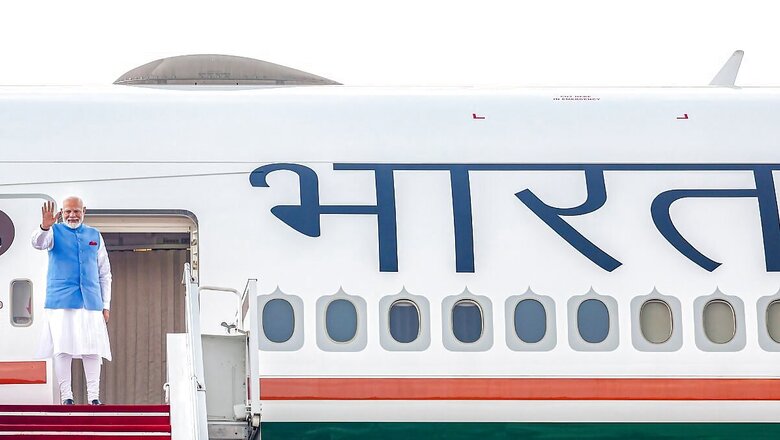
views
Prime Minister Narendra Modi, supported by officials from the Indian Ministry of External Affairs, has recently undertaken several strategic bilateral visits. These visits are designed to increase India’s profile in China’s backyard. This comes as China has been attempting to dominate and bully the ASEAN region, the countries bordering the East and South China Sea, and beyond. Additionally, these visits hold great potential for increasing bilateral trade and cooperation.
PM Modi is the first Indian head of government to visit Brunei, a strategically located and oil-rich country on the island of Borneo, to strengthen bilateral ties and economic activity. The Indian expatriate and ethnic community was greatly enthused by the brief visit, and Sultan Haji Hassanal Bolkiah, the 29th ruler in his line, extended a red-carpet welcome that was second to none. This, despite Brunei’s location in the Malay Archipelago, southeast of the Malay Peninsula, and southwest of the Philippines. It is therefore not at all far from China and the South China Sea, risking a possible menace from China for warming up towards India.
Brunei is, however, very close to the Western powers and has nothing to fear in waters regularly patrolled by the US Navy. India, as a member of QUAD and under its Act East Policy, is upgrading its previously neglected relationship with the island nation.
A new chancery was inaugurated at the Indian High Commission, located near the US Embassy, to mark the 40th anniversary of diplomatic relations between India and Brunei. News reports state that the moderate Islamic nation of Brunei and India have agreed to engage in the areas of defence, space, and the long-term supply of LNG to India. India currently imports a significant portion of its long-term LNG supplies from Qatar. A regular flight between the Brunei capital of Bandar Seri Begawan and Chennai was also announced.
Prime Minister Modi is currently in Singapore for a two-day visit. Singapore, a tiny Asian country with first-world standards, is a familiar destination for our prime minister, with steady bilateral visits from both sides over the years. Singapore has participated in the Malabar military exercises with India, alongside Japan and Australia. Additionally, Singapore and India conduct another naval exercise bilaterally, called SIMBEX, held on a yearly basis. All this, even though Singapore also enjoys a good relationship with China. It is a major transhipment port for China, serving as a key hub for trade and logistics.
Similar to Brunei, Singapore has a large, historically established Indian community, as well as modern residencies and ongoing exchanges. Indians invest in Singapore real estate, and students travel there for secondary and higher education, drawn by its high academic standards, discipline, safety, and strong law and order. Singapore is also a preferred regional headquarters for numerous US and European companies.
Prime Minister Modi met with his counterpart, Prime Minister Lawrence Wong, as well as President Tharman Shanmugaratnam (of ethnic Indian or Sri Lankan origin from the days of British indentured labour in then Malaya, following the abolition of slavery), Senior Minister Hsien Loong, and Emeritus Senior Minister Goh Chok Tong. He also met with leading members of the business community and the Indian diaspora.
Singaporean citizens trace their ancestry primarily to Malaysia, China, and India, with roots going back to the Malayan rubber plantation days of the British Empire.
Singapore is already India’s largest trading partner in Asia, with a trade value of $36.6 billion, and is a key partner in its ‘Act East’ Policy. In 2023, Singapore was the largest FDI investor in India, with investments totalling $11.77 billion.
The two prime ministers, Modi and Wong, visited AEM Holdings Ltd., a leading Singaporean company in the semiconductors and electronics sector, and discussed collaboration in this high-technology area. During the visit, the two countries elevated their bilateral cooperation to a ‘comprehensive strategic partnership’. This is an upgrade of the existing Comprehensive Economic Cooperation Agreement (CECA), established in June 2005, which had eliminated tariffs on 81 per cent of Singapore exports to India.
The two countries signed four MoUs, including one on collaboration in the semiconductor industry. The other three pertained to educational cooperation and skill development, health and medicine, and the rapidly growing field of digital technologies.
Singapore had previously agreed to play a key role in promoting India’s involvement in ASEAN countries, where China is the dominant player. Singapore is part of the global semiconductor value chain and is keen to invest in India to develop semiconductor clusters and enhance Indian talent in design and manufacturing. India, for its part, is equally enthusiastic about growing this trillion-dollar opportunity alongside its emerging electronic chip industry.
The writer is a Delhi-based political commentator. Views expressed in the above piece are personal and solely those of the author. They do not necessarily reflect News18’s views.



















Comments
0 comment